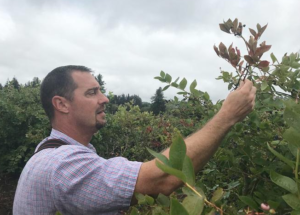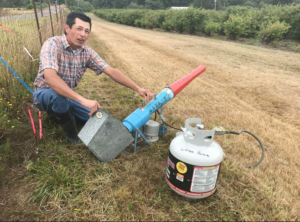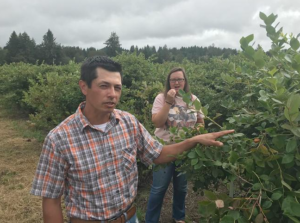
By MATEUSZ PERKOWSKI/Oregon Capital Press
SILETZ — As an island of agriculture in a sea of timber production, the owners of Gibson Farms have learned to take advantage of the operation’s distinctive circumstances.
A hook-shaped bend in the Siletz River has blessed the 200-acre farm with a rare stretch of flat, open ground in an otherwise forested, mountainous landscape.
The farm grows blueberries, cattle and hay in the center of Lincoln County, which is 87 percent forested and ranks last among the state’s counties in farm production.
“The profile of agriculture here is pretty limited,” said Alan Fujishin, whose family owns Gibson Farms.
Though most of the surrounding area is devoted to growing trees rather than crops or livestock, the owners have found plenty to appreciate about their agricultural enclave.
The location is considerably warmer and sunnier than the coast to the west, but it’s less prone to freezing than the Willamette Valley to the east.
“Even though it’s a short distance, it’s ocean-moderated,” Fujishin said.

The microclimate reduces the likelihood of both frost and heat damage to the blueberries, which are mostly early-bearing varieties meant to be harvested before the autumn rains arrive.
“They’re not being rushed, so they taste good,” Fujishin said.
Slower ripening is conducive to the concentration of sugars in the blueberries, though the fruit does take longer to mature during the summer.
“The plants are not as active in the cooler weather,” said Brenton Gibson, whose grandfather planted the bushes more than seven decades ago.
The blueberry operation now covers 20 acres.
Inconsistent pollination weather in the springtime has a silver lining as well. Although fewer flowers may get pollinated, the fruit that develops tends to grow bigger over the extended growing season.
“It seems like our berries size up a little better,” said Lorissa Fujishin, who is Alan Fujishin’s wife and Brenton Gibson’s sister.
Popular with locals and tourists
The farm is popular with residents throughout Lincoln County and even attracts tourists on their way to or from the beach.
Roughly 15 percent of the farm’s blueberry crop is sold to U-pickers, who typically buy the earliest fruit to ripen, while the rest is machine-harvested and sold to processors for freezing or drying.
Although direct marketing consumes a relatively small amount of fruit, that volume punches above its weight in terms of value — and not just financially.
Brenton Gipson said he still sees U-pickers whose faces he recognizes from childhood. The community connection provides Gibson Farms with an intangible but very real benefit in terms of public relations.
“It’s hard to quantify but it’s very much a part of farming in the modern world,” Gibson said. “It gives them some context they might not otherwise have.”
The benefit extends beyond the farm by offering consumers an opportunity to “ground truth” information they hear about agriculture, said Alan Fujishin. That’s especially useful in areas where crop and livestock production is in short supply.
“For our communities, we are that farmer,” he said. “It’s all direct and face-to-face.”
Pigeons decimate berries

However, the rainy, cold spring this year had other consequences — delayed ripening and poor fruit set in wild berries, on which local band-tailed pigeons depend.
Desperate for an alternative source of food, hundreds of birds swarmed the farm’s blueberry bushes. The family wasn’t prepared for such an early onslaught.
“We weren’t oriented toward bird damage because the fruit wasn’t even ripe yet,” said Alan Fujishin. “When they hit our early varieties, they started cleaning them out remarkably quickly.”
The farm hazed the birds with propane cannons, pyrotechnics, lasers and other methods, while seeking help from state and federal wildlife experts.
“It became clear the problem was bigger than the tools we have combined,” Fujishin said.
By late July up to 700 pigeons were feasting on the blueberry crop, ultimately erasing roughly $80,000 from the farm’s expected revenues by taking the first and second picking of blueberries. In addition to losing the blueberries, the bushes were damaged by so many relatively heavy birds sitting on their branches.
Wildlife authorities decided against allowing lethal removal of any birds, since their population isn’t considered robust in the area.
It’s rare for the federal government to approve lethal bird removal, but the method isn’t particularly effective anyway, said Jason Kirchner, the Newport-based wildlife biologist with the Oregon Department of Fish and Wildlife.
Unlike other animals, birds will still tend to come back even if members of their flock are killed, Kirchner said. “It would be detrimental to the population to keep killing them.”
Crop damage from pigeons is common in Oregon but the concentration at the Gibson’s farm was unusual for the Coast Range.
“At this intensity level, it was a crazy year,” Kirchner said. “It’s a hundred times worse when the wild berries aren’t there.”
The pigeons ultimately ate most of the blueberry crop after the farm had already spent money trying to haze the intruders. The financial toll was serious and the operation will be forced to cut back on fungicides and fertilizer next year, adversely affecting future yields.
“Things will be tight next year,” said Lorissa Fujishin.
Diversify, diversify

While blueberries represent a substantial portion of the farm’s income, the operation has long recognized the importance of diversification.
Cattle are a natural fit for the coastal climate, where the lush pastures help them put on weight.
The farm is mostly a cow-calf operation, but sells a limited amount of locker beef directly to friends and family.
Producing hay, on the other hand, is a challenge because the sunny, dry conditions needed for harvest seldom last long.
The farm mitigates that problem by making high-moisture “haylage,” which is baled when still moist and allowed to ferment without oxygen while wrapped in plastic.
“We can produce all our own forage here,” Fujishin said. “We don’t have to bring in hay from the east side or the valley.”
The Gibson family traces its roots to ancestors who came to America on the Mayflower voyage, while others traveled by wagon train on the Oregon Trail.
Railroad construction brought the Gibsons to the Coast Range, where they established their Siletz homestead in the mid-20th century.
The family initially grew flower bulbs in the area, eventually shifting to other ventures. While the blueberries and cattle have remained on the farm, the strawberry and raspberry operations have been discontinued.
This year’s bird onslaught was a setback, but the farm has adjusted to survive similar disasters before.
“That’s farming, though,” Brenton Gibson said. “Pivoting, balancing.”
- Mateusz Perkowski is a reporter at the Capital Press and can be reached at MPerkoski@CapitalPress.com. This is a compilation of two stories that appeared in the Capital Press in August and September.



I picked blueberries for Gibson farm as a teenager. 15cents/lb. Those were the days. ha